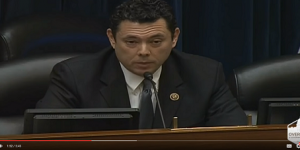A new analysis shows just how illegal aliens could tip the 2016 Presidential election to Hillary Clinton even if no illegal alien casts a vote.
Illegal immigrants—along with other noncitizens without the right to vote—may pick the 2016 presidential winner. Thanks to the unique math undergirding the Electoral College, the mere presence of 11-12 million illegal immigrants and other noncitizens here legally may enable them to swing the election from Republicans to Democrats.
While illegal aliens supposedly can’t vote, they are counted in the Census. This is important because the Constitution apportions seats in the House of Representatives by the “whole number of persons in each state”.
States with a high number of illegal aliens receive more seats in the House than their voting-eligible population would suggest and those with smaller illegal alien populations get fewer.
Since Electoral votes for President are distributed by number of members of Congress in each state (two Senators plus the number of Representatives) those states with high numbers of illegals get more than their share of electoral votes as well.
This math gives strongly Democratic states an unfair edge in the Electoral College. Using citizen-only population statistics, American University scholar Leonard Steinhorn projects California would lose five House seats and therefore five electoral votes. New York and Washington would lose one seat, and thus one electoral vote apiece. These three states, which have voted overwhelming for Democrats over the latest six presidential elections, would lose seven electoral votes altogether. The GOP’s path to victory, by contrast, depends on states that would lose a mere three electoral votes in total. Republican stronghold Texas would lose two House seats and therefore two electoral votes. Florida, which Republicans must win to reclaim the presidency, loses one seat and thus one electoral vote.
But that leaves the electoral math only half done. The 10 House seats taken away from these states would then need to be reallocated to states with relatively small numbers of noncitizens. The following ten states, the bulk of which lean Republican, would likely gain one House seat and thus one additional electoral vote: Iowa, Indiana, Louisiana, Michigan, Missouri, Montana, North Carolina, Ohio, Oklahoma and Pennsylvania.
Iowa has gone Democratic six out of the last seven times. Michigan and Pennsylvania have both gone comfortably Democratic in every election since 1992. But five states—Indiana, Louisiana, Missouri, Montana and Oklahoma—all went by double-digit margins to GOP presidential nominee Mitt Romney in 2012. And Romney carried North Carolina by two percent while losing nationally by nearly four percent, a large difference. Likewise, despite solidly beating 2008 GOP nominee John McCain by seven percent nationally, President Obama eked out a bare 0.3 percent win in the Tar Heel State. The current Ohio polls also look promising for the right GOP nominee, and no Republican has ever won the Presidency without carrying the Buckeye State. There is no plausible statistical path for the Republican Party’s nominee to win an electoral majority without these states.
Accordingly, for analytic purposes, three of the states that would gain electoral votes are Democratic. The remaining seven are fairly put in the GOP column. Combining the two halves of the citizen-only population reapportionment, states likely in the Democratic column suffer a net loss of four electoral votes. Conversely the must-win Republican leaning states total a net gain of four electoral votes. These are the four electoral votes statistically cast by noncitizens.
The narrow margins between the two major party nominees make something like the distribution of Electoral votes critical.
Florida (29), Ohio (18) and Virginia (13) collectively have 60 electoral votes. Adding these Obama states to the Romney 24 gives the next GOP presidential standard-bearer 266 electoral votes, four short of the magic 270. But had the House of Representatives been apportioned by citizen-only figures, the GOP nominee would get 270 electoral votes by carrying these 27 states. There would be no need to win an additional Democratic leaning state.
But under the current system, they must. Which one of the 23 remaining might it be? President Obama carried D.C. and 16 states by double-digit margins. Four other states were carried by comfortable percentages and demographically appear very likely in the Democratic column without a major shift from the near quarter-century statistical norm. The GOP’s best hopes would seem to be Colorado (9 electoral votes), Iowa (6), and New Hampshire (4).
The Centennial State, once a reliable Rocky Mountain Republican bastion, seems to have flipped due to a growing Hispanic population. Hillary Clinton’s poll numbers have been particularly bad there recently, but they may well recover before Election Day. Compared to once dependably Republican Nevada, Colorado seems the easier Rocky Mountain state for the Republicans to flip next time, but it is far from a sure bet.
Iowa’s Democratic leanings continue to baffle farm state Republicans. But starting 1988, the GOP presidential nominee has lost the Corn State every time since except for President Bush’s 0.7 percent win in 2004. Against a credible Democratic nominee, history puts the GOP candidate in the underdog position.
This leaves New Hampshire, once an erstwhile reliable GOP State. George H.W. Bush won the Granite State by 26 percent in 1988. But since then, Democrats have won every time but once: a slim 1 percent win by GOP nominee George W. Bush in 2000. The 2016 GOP nominee will again need to beat the statistical tide.
The Electoral College math suggests two plausible paths for a narrow GOP win next year. The Republican nominee wins every Romney state, all three key swing states, and either Colorado, Iowa or New Hampshire. In the alternative, the historical numbers give the GOP standard-bearer 272 electoral votes by (1) carrying all the Romney states, (2) winning Florida and Ohio, (3) losing Virginia but (4) pulling off a Colorado, Iowa and New Hampshire trifecta. This last scenario is very unlikely.
***
This is why counting illegal immigrants and noncitizens significantly reduces the chances of the GOP winning the presidency. Given Obama’s winning margins last time in Florida, Ohio and Virginia, a GOP path to winning 27 states is credible at this point in the presidential cycle. But due to the Electoral College math, this only gives Republicans 266 electoral votes, not 270.




























